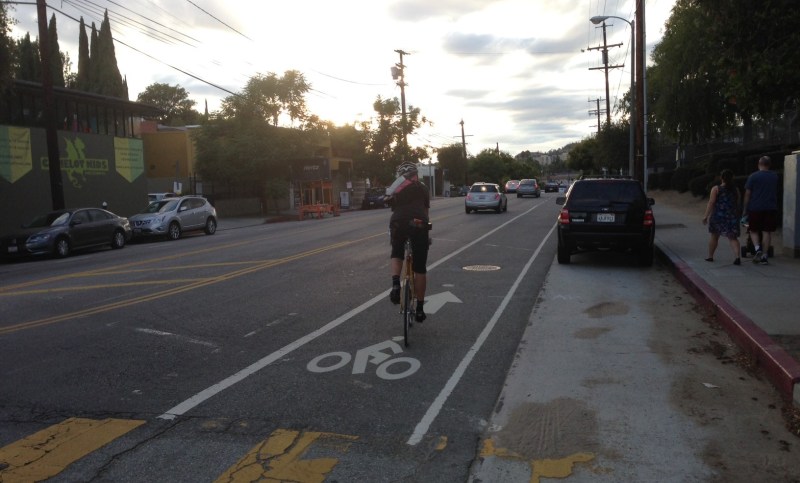Despite proven safety results, Silver Lake's Rowena Avenue road diet is facing questions from car-centric neighbors pushing to see it undone. The issue is expected to be discussed tonight at a meeting of the Transportation Committee of the Silver Lake Neighborhood Council. Keep Rowena Safe is urging stakeholders attend the meeting, which will take place at 6:30 p.m. at the Silver Lake Library at 2411 Glendale Boulevard.
In response to the 2012 death of Ashley Sandau, killed by a motorist while she crossed Rowena Avenue, the city Transportation Department (LADOT) implemented a road diet to make Rowena safer. For about half a mile between Glendale Boulevard and Hyperion Avenue, Rowena's four car lanes were reduced to three. An LADOT review of the project found that post-diet Rowena supports roughly the same volume of cars as pre-diet, but does so with reduced speeds and fewer collisions.
The road diet implementation was supported by then-Councilmember Tom LaBonge. He was termed out and, in 2015, David Ryu was elected to the L.A. City Council to represent the area. Ryu has expressed skepticism about road diets, asserting that they are “creating traffic” and having “unintended consequences.” Ryu decided against a proposed road diet for 6th Street in mid-city.
At the urging of road diet foes, Ryu's office commissioned consultants Kimley-Horne to further study Rowena. In 2017, Ryu spokesperson Estevan Montemayor characterized the goal of the study as "to provide mitigations for cut-through traffic in the residential neighborhood adjacent to Rowena Avenue while continuing to prioritize public safety for all."
The $88,000 Kimley-Horne study is apparently complete and has been shared with some stakeholders.
The study does not appear to be available online. Streetsblog emailed Ryu's office to request the study. They responded that they would "check on it" but have not yet provided the study.
According to one source (who declined to be identified) who read the study, it does include recommendations for addressing cut-through traffic, primarily on parallel streets Angus Street and Waverly Drive. According to the source, despite including "data that clearly shows reduction in collisions since 2013 when the road diet was implemented" the report "goes sideways in the last two pages, where inexplicably three options are introduced as alternatives to the existing Rowena roadway alignment" and "there is no analysis or rationale presented in support of altering the current road diet roadway configuration, nor for the three alternatives." According to the source, the report's alternatives are:
- Option 1: allow the existing road diet to remain
- Option 2: remove bike lanes in both directions and repurpose as additional eastbound vehicular lane
- Option 3: remove parking and bike lane in eastbound direction and replace with a sharrow lane
- Option 4: restrict street parking during peak a.m./p.m. commute hours and use parking zone and sharrow lanes in both directions
Streetsblog will continue to try to obtain the actual publicly-funded study, but if this source is correct, the report appears to lay the groundwork to remove the Rowena Avenue road diet and bike lanes. Undoing the road diet would make Rowena more dangerous, and would set a poor precedent for city Vision Zero efforts to reduce traffic deaths and injuries.
The recommended interventions on Waverly and Angus would make a lot of sense; they appear somewhat similar to the recent improvements to keep nearby Baxter Street safer from cut-through traffic. In the past, LADOT had proposed similar interventions for Angus and Waverly, but they were opposed by road diet opponents. If the new study can help spur improvements to these parallel streets it would do some good.






